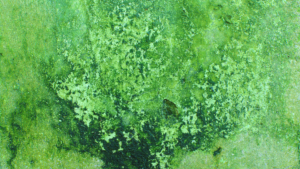Molds are a type of fungus that can be found both indoors and outdoors. They grow in warm, moist environments and can cause health problems in people who are allergic to them.
In this blog post, we’ll take a look at how long it takes for mold to grow, and what factors influence its growth rate. We’ll also discuss the health dangers of mold exposure and if it’s a wise decision to conduct your own mold testing. Stay safe!
What Causes Mold Growth?
Mold growth is something that often happens after water damage.
Mold spores need a source of moisture and an organic food source to grow, but the moisture source is the most important of the two. Because of this, mold growth often happens after water damage. Mold spores need moisture to grow, which the extra water provides. This moisture is usually found in building materials.
Mold eats cellulose, found in wood, drywall, insulation, and other common building materials. Mold can grow on these things because they are common in homes and businesses. It only needs water to start growing. Mold will begin to grow when it finds too much water and has enough time.
How Long Does Mold Grow and Spread?
Many factors influence how long mold takes to develop and appear, such as the type of mold, the materials it’s growing on, and how much water it has. Mold can start to grow and spread as soon as 24 hours after it comes into contact with a source of moisture. Mold spores will begin to grow in 3 to 12 days. Mold can be seen after 18 to 21 days.
In general, the longer there is moisture, the more likely mold will grow and spread.
When mold spores land on a wet surface, it starts to grow within a few hours. It spreads through the material and releases thousands of mold spores into the air. The mold spores can then move to other damp places on your property and cause problems.
Can Mold Dry Up?
Mold spores become inactive after drying but remain a danger as long as they are present in the air. It may cause skin rashes, runny nose, itchy eyes, coughing, and sneezing. This happens even if the mold spores are inactive since they may quickly become airborne as the air in and out of the home circulates. Once in the air, they may roam about and choose a site that suits their development. Mold needs moisture to thrive but may stay inactive unless exposed to water or high humidity.
What If I Don’t Remove Mold?
When mold develops on a surface, the surface materials serve as its food supply. As it consumes organic material, it destroys its structure. The more time mold has to eat away at something, the more damage it does. If the mold isn’t treated, it will destroy the surface’s structure and make it useless and impossible to fix.
When it comes to health, anyone exposed to mold can get allergies, which can cause coughing, wheezing, and skin and eye irritation. If the exposure goes on for a long time, the problems will worsen.
When is the right time for Mold Inspection?
One good thing about mold is that you know it’s in your house if you can see it. If you see mold growing in the cracks and holes of your walls, it is growing and sending out more spores. Remember that mold can grow in places you can’t see, like in your ducts or between your walls. It may also make tiny colonies that are hard to see. A few things should make you look for mold in your home.
Water problems. Check for mold if your basement flooded, your roof leaked, or a broken pipe sprayed water all over your kitchen. Mold could grow in any place that got wet and didn’t dry out quickly (within 24 to 48 hours).
You see some mold. If you see things growing in your house that is green, blue, black, or white, you should have a mold inspection to make sure you find everything. It might not be limited to one location.
Buying a new house. Water damage in a home is impossible to predict. A mold inspection is the only way to find out if there is mold.
When a house has been empty for a while, humidity could have built up inside and caused mold to grow. This is a big problem in places where it is hot and humid.
After mold remediation. If you’ve taken the often expensive and complicated steps to get rid of mold, it’s good to have mold inspections done regularly to make sure you get rid of it all.
Should I Do Mold Testing Myself or Call a Professional?
If you need mold testing done in your house, you should call the pros. Mold test kits for home use are readily available and reasonably priced. But they aren’t usually accurate, and some only test for a few common molds. Those limited tests may overlook the mold developing in your house, giving you a false negative result.
User mistakes may also influence the accuracy of do-it-yourself mold testing. Mold testing is precise and simple to mess up if you aren’t acquainted with the technique. Mold testers are generally engineers who follow a strict method for achieving reliable outcomes.
Mold Testing: It’s always best to leave it to the professionals!
If you’re seeing any signs of mold growth in your home, it’s essential to take action right away. Mold can not only cause health problems for you and your family, but it can also damage your home. That’s why it’s so important to have a professional inspection as soon as possible. Golden State Mold Inspections offers fast, reliable inspections that will help you determine whether or not there is mold in your home and what needs to be done to get rid of it. So don’t wait – book an appointment today!

